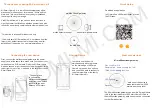
VOICE MAIL
The OfficeServ 7100 voice mail/auto attendant is included with every OfficeServ 7100 system as a standard
feature. It is embedded in the main system program and provides 4 ports of voice processing. Because it is
embedded into the system it provides such features as one touch call record, answering machine emulation,
and voice mail box administration with interactive keyset displays.
The OfficeServ 7100 system uses MGI channels (VoIP) at G.726 compression to communicate with the
embedded voicemail application. Stations can call forward to a voice mail. Keyset users can press one button
to retrieve messages from the voice mail system. A Voice Mail Transfer key permits keyset users to easily trans-
fer a caller directly to an individual voice mail box without navigating through menus.
Note: The OfficeServ 7100 does not support 3rd party voice mail applications.
Voice Over Internet Protocol (VoIP)
The OfficeServ 7100 system is VoIP enabled and as such supports the following VoIP services:
1)
H.323 Trunking
2)
SIP IP Trunking
3)
IP Telephone Sets: OfficeServ ITP-5107S, ITP-5121D and ITP-5112L, and OfficeServ Softphone.
These IP Keysets can be installed in the local office or in a remote office, home office with full feature
operation.
4)
IP Networking: Connect up to 99 systems together over a managed IP network.
The embedded OfficeServ 7100 Media Gateway Interface (MGI) channels support 8 voice calls using VoIP
services per card over an IP network connection. The Officeserv 7200 MGI16 card can be added into any uni-
versal OfficeServ 7100 card slot. The OfficeServ 7100 supports a maximum of one MGI-16 card per system.
The OfficeServ 7100 MP10a comes with 8 MGI channels built-in and can be activated with the appropriate
license key. A total of 24 MGI channels can be supported.
With VoIP certain compression standards have also been adopted to represent each second of voice with an
amount of bandwidth. The OfficeServ 7100 MGI utilizes G.711, G.729, G.729A or G.723 standards voice com-
pression codec’s. This allows for a selectable 64kbps (G711), 8Kbps (G729A) or 6.3Kbps (G723) bandwidth use
when preparing voice compression for IP transport. Compression is used to reduce the digitized voice into a
smaller bandwidth that can be carried in smaller packets. The VoIP gateway determines the compression
method for each call setup. There is also a certain amount of frame/packet overhead in each compression
channel. 64K of bandwidth can support 6~7 calls simultaneously. This can vary depending on efficiency fea-
tures like Silence Suppression and multiframe counts. Unlike switched networks, VoIP connections consist of
a sequence of numbered data packets. Since voice conversation is usually considered “real time” these pack-
ets need to be delivered in a consistent manner with minimal delay.
In any Ethernet environment, packet transfers are subject to delays and/or loss. If these delays are greater
than 200ms the voice quality will deteriorate. The Ethernet data traffic and network topology should be a
consideration when using VoIP. Network congestion will affect call quality in any VoIP application.
WALKING CLASS OF SERVICE
This feature allows users to make calls or use features from a station that is restricted. The users may either
use the WCOS feature code or the authorization code feature. Both methods change the class of service to
correspond with the station passcode or authorization code that is dialed. After the call is completed, the sta-
tion returns to its programmed class of service.
WIRELESS LAN—
4.29
Home Page
Table of Contents
















































